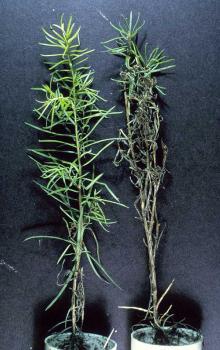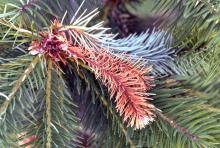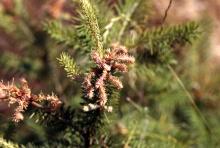See:
Greenhouse Plants, Ornamental - Gray Mold
Cause Botrytis cinerea, a fungus that can be involved in damping-off of young seedlings, a seedling blight in the greenhouse, field or cold storage, and even a shoot blight of older trees in nurseries or Christmas tree plantations. Current-season shoots of conifers may be infected. Cool temperature and moist conditions favor disease development. Close tree spacing coupled with dense foliage and poor air circulation in Christmas tree plantings provide an excellent condition for gray mold blight. The fungus overwinters as sclerotia on infected twigs and needles. More of a problem in greenhouse container nurseries than in bareroot nurseries.
Symptoms Curling, twisting, withering, browning, and dying of current-season shoots are diagnostic symptoms. Gray fungal growth over infected areas in moist conditions distinguishes this damage from a physiological disorder caused by frost. May occur in the lower foliage first before moving up and killing needles and woody portions of the shoot.
Cultural control
- Reduce tree density and select sites for good air circulation.
- Maintain greenhouse humidity below 90%.
- Improve air circulation in greenhouse or hoophouse structures by leaving end walls open during fall or by installing fans.
- Remove and destroy crop residue in production areas.
- Use proper fertility to maintain healthy growth.
Chemical control Use in conjunction with cultural controls. Rotate or tank-mix materials from different groups with different modes of action to avoid developing resistant fungal populations. Limit the use of any one group during the growing season.
- Astun at 10 to 17 fl oz/100 gal water is registered for container and field grown ornamental plants. Group 7 fungicide. 12-hr reentry.
- Chlorothalonil (Bravo Weather Stik or Ultrex, Daconil Weather Stik or Ultrex, Echo 720) for conifer nursery beds. Use Bravo Weather Stik at 1.5 to 2.75 pints/100 gal water. May cause brown splotches on noble fir, some of which are microscopic. Group M5 fungicides. 12-hr reentry.
- Decree 50 WDG at 0.75 to 1.5 lb/100 gal water. Registered for outdoor, greenhouse, and nursery grown ornamentals, and forestry conifers. Group 17 fungicide. 12-hr reentry.
- Mancozeb-based products can be used as mixing partners and provide some protection. Group M3 fungicides. 24-hr reentry.
- Dithane M45 at 2 to 4 lb/A or per 100 gal water. 14-day PHI. Registered for use on Christmas trees.
- Fore 80 WP at 1.5 lb/100 gal water plus a spreader-sticker. Registered for outdoor or greenhouse use.
- Penncozeb 75 DF at 2 to 4 lb/A. 14-day PHI. Registered for use on Christmas trees.
- Protect DF at 1 to 2 lb/100 gal water plus 2 to 4 oz spreader-sticker. Registered for field, nursery and greenhouse grown plants including Christmas trees.
- OHP 6672 4.5 F at 10 to 14.5 fl oz/100 gal water plus another fungicide. Registered for evergreens grown in the nursery, greenhouse or landscape. Group 1 fungicide. 12-hr reentry.
- Orkestra at 8 fl oz/100 gal. Registered for evergreens grown in forest and conifer nurseries and plantations. Group 7 + 11 fungicide. 12-hr reentry.
- Pageant at 12 to 18 oz/100 gal water. Do not use with organosilicone-based adjuvants. Registered for forest and conifer nurseries, and plantations. Group 7 + 11 fungicide. 12-hr reentry.
- Spectro 90 WDG at 1 to 2 lb/100 gal water. Registered for conifers grown in nursery, greenhouse or landscape. Group 1 + M5 fungicide. 12-hr reentry.
- Terraguard SC at 4 to 8 fl oz/100 gal water. Registered for nurseries including Christmas tree/conifer plantations. Group 3 fungicide. 12-hr reentry.
Biological control Use in conjunction with other control tactics such as thorough sanitation.
- LALStop G46 WG (Clonostachys rosea [formerly Gliocladium catenulatum] strain J1446) at 0.13 oz/1 gal water. Do not use with other products in the tank. 4-hr reentry. O
Reference Peterson, M.J., Sutherland, J.R., and Tuller, S.E. 1988. Greenhouse environment and epidemiology of grey mould of container-grown Douglas-fir seedlings. Canadian Journal of Forest Research 18:974-980.




